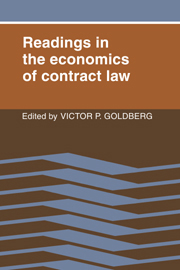Book contents
- Frontmatter
- Contents
- Preface
- Readings in the economics of contract law
- Part I Some preliminaries
- Part II Contract law and the least cost avoider
- Part III The expectation interest, the reliance interest, and consequential damages
- 3.1 The reliance interest in contract damages
- 3.2 Note on price information and enforcement of the expectation interest
- Questions and notes on protecting the property interest in the price
- 3.3 The contract–tort boundary and the economics of insurance
- 3.4 Notes on the reliance interest
- Questions and notes on fault, consequential damages, and reliance
- Part IV The lost-volume seller puzzle
- Part V Specific performance and the cost of completion
- Part VI Power, governance, and the penalty clause puzzle
- Part VII Standard forms and warranties
- Part VIII Duress, preexisting duty, and good faith modification
- Part IX Impossibility, related doctrines, and price adjustment
- Questions and notes on impossibility and price adjustment
- References
- Index of cases
- Author index
- Subject index
Questions and notes on fault, consequential damages, and reliance
Published online by Cambridge University Press: 10 November 2010
- Frontmatter
- Contents
- Preface
- Readings in the economics of contract law
- Part I Some preliminaries
- Part II Contract law and the least cost avoider
- Part III The expectation interest, the reliance interest, and consequential damages
- 3.1 The reliance interest in contract damages
- 3.2 Note on price information and enforcement of the expectation interest
- Questions and notes on protecting the property interest in the price
- 3.3 The contract–tort boundary and the economics of insurance
- 3.4 Notes on the reliance interest
- Questions and notes on fault, consequential damages, and reliance
- Part IV The lost-volume seller puzzle
- Part V Specific performance and the cost of completion
- Part VI Power, governance, and the penalty clause puzzle
- Part VII Standard forms and warranties
- Part VIII Duress, preexisting duty, and good faith modification
- Part IX Impossibility, related doctrines, and price adjustment
- Questions and notes on impossibility and price adjustment
- References
- Index of cases
- Author index
- Subject index
Summary
1. As Bishop notes, the foreseeability doctrine in contracts has little to do with the possible occurrence of low-probability events. It concerns the ability of the parties to control the magnitude of the damages that actually occur. Bishop emphasizes one device for doing so: providing notice of the special circumstances. An alternative, which he does not consider, is for the parties to arrange their affairs so that the magnitude of the damages would not be so great if the other party failed to perform. That is, in Hadley v. Baxendale the shipper could have reduced the expected cost of a breach by informing the carrier of the consequences of a failure to deliver or by carrying a greater inventory of shafts so that the plant would not have to remain idle in the event of a delay (breach) by the carrier.
The possibility that Hadley could have held a larger inventory of shafts (an input) has been widely recognized. Less attention has been given to other ways in which the costs of the failure could have been limited by timely effort on the part of Hadley. Hadley could have held a larger inventory of flour (the output). After the shaft was delivered and the mill again operating, Hadley could have made up for some of the lost output by running at a higher level of output than he otherwise would have. (In effect, that entails having a larger inventory of productive capacity – another input – than Hadley might otherwise carry.)
- Type
- Chapter
- Information
- Readings in the Economics of Contract Law , pp. 99 - 104Publisher: Cambridge University PressPrint publication year: 1982



